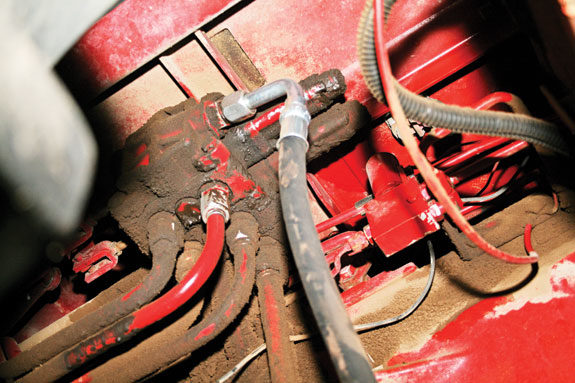A dairyman in the Magic Valley, Idaho, came up to me and asked if he was right in thinking he could replace his broken steel line with proper rubber hydraulic hoses. He had a steel line break, and it was going to take him a week to get the part in. He couldn’t afford to have the machinery out of commission for that long. I told him he was correct. Rubber hydraulic hoses can replace steel hoses, but there are some things to consider.
The first thing you need to look at is the inside diameter. The hoses must have the same inside diameter so that the flow and pressure are consistent with the way the tractor was designed.
Then look at how much pressure is put through the lines. This will determine the size of the rubber hydraulic hose you will need. Hydraulic hoses range from 3,000 PSI to 10,000 PSI. There are three types of hoses: single, double- and triple-braided hoses. Check with the manufacturer and hydraulics dealer for pressure ratings and proper hoses for the application you’re working on.
The next thing you need to do is protect the hoses from sharp edges. Flexible hoses will move and could rupture – leaving you with a mess and a broken piece of equipment. Inspect the area around the hoses, and if there are possible sharp edges, then adding some casing or protection to the hose would be advisable. Making sure your hoses are properly clamped will also help protect your lines.
There are many different kinds of fittings. In the picture (above right), the high-pressure auxiliary line that raises and lowers the implement was broken. That steel line wasn’t made anymore and was out of service. So I put a 90- degree fitting so that the hose could clear the housing and other lines. The fitting you use will depend on where and how you use the hydraulic line.
Why change?
Steel lines are preformed to fit the specific machinery. Steel lines have one good advantage on rubber hoses: They let off high heat, which helps cool the oil. The rubber hoses insulate and trap the heat more. This is not a major concern though, because the oil and engine are cooled with the cooling system. Steel hoses can be cheaper than rubber hoses on some models.
The rubber hoses are more readily available and are easier to replace than steel lines. On some equipment you have to take the cab off in order to replace the steel lines. The rubber hoses can last a long time because they absorb the shock and vibration caused by the equipment. The main reasons you might choose to change steel lines for hydraulic hoses are because the lines are not available, they will take a week or two to get the line or you would have to disassemble half the tractor to replace it.
Mechanic’s tip:
What does permanent antifreeze mean to you? If you think it means you don’t have to change it, you are mistaken. Permanent antifreeze means it works well during the winter and the summer. Antifreeze used to be put in only during the winter. All antifreeze is now considered permanent, but that doesn’t mean you don’t change it. PD

-
Jim Schlund
- Retired Diesel
- Mechanics Professor
- College of Southern Idaho
PHOTO: You can see all the red steel hoses that were originally installed. The black hose with silver fitting is a hose that was recently put on. Rubber hoses are easier to work with in most cases.Photo by Ryan Curtis.






